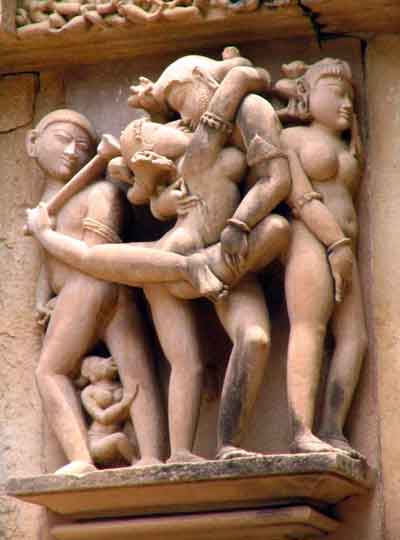Khajuraho Travel Guide:

Introduction
The Khajuraho Group of Monuments in Khajuraho a town in the Indian state of Madhya Pradesh, located in Chhatarpur District, about 620 kilometres (385 mi) southeast of New Delhi, are one of the most popular tourist destinations in India. Khajuraho has the largest group of medieval Hindu and Jain temples, famous for their erotic sculpture. The Khajuraho group of monuments has been listed as a UNESCO World Heritage Site, and is considered to be one of the "seven wonders" of India.
The name Khajuraho, ancient "Kharjuravahaka", is derived from the Sanskrit words kharjura = date palm and vahaka = "one who carries".
History
In the 27th century of the Kali Yuga[when?] (ca. 500-400 BCE?), the Mlechcha invaders, or barbarians, started attacking North India[citation needed]. Some Bargujar Rajputs moved eastward to central India; they ruled over the Northeastern region of Rajasthan, called Dhundhar, and were referred to as Dhundhel or Dhundhela in ancient times, for the region they governed. Later on they called themselves Bundelas and Chandelas; those who were in the ruling class having gotra Kashyap were definitely all Bargujars; they were vassals of Gurjara - Pratihara empire of North India, which lasted from 500 C.E. to 1300 C.E. and at its peak the major monuments were built. The Bargujars also built the Kalinjar fort and Neelkanth Mahadev temple, similar to one at Sariska National Park, and Baroli, being Shiva worshippers
The city was the cultural capital of Chandela Rajputs, a Hindu dynasty that ruled this part of India from the 10-12th centuries. The political capital of the Chandelas was Kalinjar. The Khajuraho temples were built over a span of 200 years, from 950 to 1150. The Chandela capital was moved to Mahoba after this time, but Khajuraho continued to flourish for some time. Khajuraho has no forts because the Chandel Kings never lived in their cultural capital.
The whole area was enclosed by a wall with eight gates, each flanked by two golden palm trees. There were originally over 80 Hindu temples, of which only 25 now stand in a reasonable state of preservation, scattered over an area of about 20 square kilometres (8 sq mi).
Today, the temples serve as fine examples of Indian architectural styles that have gained popularity due to their explicit depiction of sexual life during medieval times. Locals living in the Khajuraho village always knew about and kept up the temples as best as they could. They were pointed out to an Englishman in late 19th century but the jungles had taken a toll on all the monuments.
Town
Khajuraho is a town in the Indian state of Madhya Pradesh, located in Chhatarpur District, about 620 kilometres (385 mi) southeast of New Delhi, the capital city of India.
One of the most popular tourist destinations in India, Khajuraho has the largest group of medieval Hindu and Jain temples, famous for their erotic sculpture. The Khajuraho group of monuments has been listed as a UNESCO World Heritage Site, and is considered to be one of the "seven wonders" of India.
The name Khajuraho, ancient "Kharjuravahaka", is derived from the Sanskrit word kharjur meaning date palm.
Geography
Khajuraho is at 24°51'N 79°56'E? / ?24.85°N 79.93°E? / 24.85; 79.93.[1] It has an average elevation of 283 metres (928 feet).
Demographics
As of 2001[update] India census, Khajuraho had a population of 19,282. Males constitute 52% of the population and females 48%. Khajuraho has an average literacy rate of 53%, lower than the national average of 59.5%: male literacy is 62%, and female literacy is 43%. In Khajuraho, 19% of the population is under 6 years of age.
Architecture
The temples are grouped into three geographical divisions: western, eastern and southern.
The Khajuraho temples are made of sandstone. The builders didn't use mortar: the stones were put together with mortise and tenon joints and they were held in place by gravity. This form of construction requires very precise joints. The columns and architraves were built with megaliths that weighed up to 20 tons.
These temples of Khajuraho have sculptures that look very realistic and are studied even today.
The Saraswati temple on the campus of Birla Institute of Technology and Science, Pilani, India, is modeled after the Khajuraho temple.
Landscape
The Khajuraho temples are now set in a parkland landscape. When India gained independence from Britain in 1947 the landscape setting was semi-desert and scrub. The archaeological park now has something of the character of a public park, with mowed grass, rose beds and ornamental trees. This may be popular with visitors but has no relationship with the historic landscape at the time the temples were built.
The development of landscape archaeology as an academic discipline raises questions concerning the earlier landscape of Khajuraho and the original relationship between the temple complex and the surrounding area. There are no records of what the original landscape might have been, but it is known that a large community of priests used the temple complex and that Indian gardens in the tenth century were predominantly tree gardens. They did not have lawns or herbaceous flowering plants.
See also
* Bambar Baini the famous temple located on a hill in Laundi.
* Kandariya Mahadeva
* Hemvati
* Kalinjar
* Beejamandal
* Jain temples of Khajuraho
* List of megalithic sites
* Madhya Pradesh
* Bandhavgarh National Park